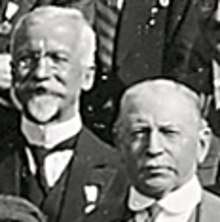Andrew Forsyth
Andrew Russell Forsyth, FRS,[1] FRSE (18 June 1858, Glasgow – 2 June 1942, South Kensington) was a British mathematician.[2][3]
Andrew Russell Forsyth | |
|---|---|
 Andrew Forsyth (right) with Élie Cartan at the ICM 1932 | |
| Born | 18 June 1858 Glasgow, Scotland |
| Died | 2 June 1942 South Kensington, England |
| Alma mater | Trinity College, Cambridge |
| Awards | Royal Medal (1897) |
| Scientific career | |
| Fields | Mathematics |
| Institutions | University of Liverpool Trinity College, Cambridge |
| Academic advisors | Arthur Cayley |
| Notable students | Edmund Taylor Whittaker |
Life
Forsyth was born in Glasgow on 18 June 1858, the son of John Forsyth, a marine engineer, and his wife Christina Glen.[4]
Forsyth studied at Liverpool College and was tutored by Richard Pendlebury before entering Trinity College, Cambridge, graduating senior wrangler in 1881.[5] He was elected a fellow of Trinity and then appointed to the chair of mathematics at the University of Liverpool at the age of 24. He returned to Cambridge as a lecturer in 1884 and became Sadleirian Professor of Pure Mathematics in 1895.
Forsyth was forced to resign his chair in 1910 as a result of a scandal caused by his affair with Marion Amelia Boys, née Pollock, the wife of physicist C. V. Boys. Boys was granted a divorce on the grounds of Marion's adultery with Forsyth. Marion and Andrew Forsyth were later married.
Forsyth became professor at the Imperial College of Science in 1913 and retired in 1923, remaining mathematically active into his seventies. He was elected a Fellow of the Royal Society in 1886[1] and won its Royal Medal in 1897. He was a Plenary Speaker of the ICM in 1908 at Rome.[6]
He is now remembered much more as an author of treatises than as an original researcher. His books have, however, often been criticized (for example by J. E. Littlewood, in his A Mathematician's Miscellany).[7] E. T. Whittaker was his only official student.[3]
He died in London on 2 June 1942 and was cremated at Golders Green Crematorium.[4]
Forsyth received the degree of Doctor mathematicae (honoris causa) from the Royal Frederick University on 6 September 1902, when they celebrated the centennial of the birth of mathematician Niels Henrik Abel.[8][9]
Family
Forsyth married Marion Amelia Pollock in 1910.[1]
Works
- A Treatise on Differential Equations (1885)
- Theory of Functions of a Complex Variable (1893)
- Geodesics on an oblate spheroid(1895–96)
- Theory of Differential Equations (1890–1906) six volumes
- Lectures on the Differential Geometry of Curves and Surfaces (1912)
- Lectures Introductory to the Theory of Functions of Two Complex Variables(1914)
- Calculus of Variations (1927)
- Geometry of Four Dimensions (1930)
- Intrinsic Geometry of Ideal Space (1935)
References
- Whittaker, E. T. (1942). "Andrew Russell Forsyth. 1858–1942". Obituary Notices of Fellows of the Royal Society. 4 (11): 208–226. doi:10.1098/rsbm.1942.0017.
- O'Connor, John J.; Robertson, Edmund F., "Andrew Forsyth", MacTutor History of Mathematics archive, University of St Andrews.
- Andrew Forsyth at the Mathematics Genealogy Project
- Biographical Index of Former Fellows of the Royal Society of Edinburgh 1783–2002 (PDF). The Royal Society of Edinburgh. July 2006. ISBN 0-902-198-84-X.
- "Forsyth, Andrew Russell (FRST877AR)". A Cambridge Alumni Database. University of Cambridge.
- Forsyth, A. R. (1909). "On the present condition of partial differential equations of the second order as regards formal integration". In G. Castelnuovo (ed.). Atti del IV Congresso Internazionale dei Matematici (Roma, 6–11 Aprile 1908). vol. 1. pp. 87–103.
- Littlewood, John Edensor (1986). A Mathematician's Miscellany. Cambridge University Press. p. 135. ISBN 9780521337021.
A. R. Forsyth wrote a CUP book on functions of two complex variables. It is a thoroughly bad book.
- "Foreign degrees for British men of Science". The Times (36867). London. 8 September 1902. p. 4.
- "Honorary doctorates from the University of Oslo 1902–1910". (in Norwegian)